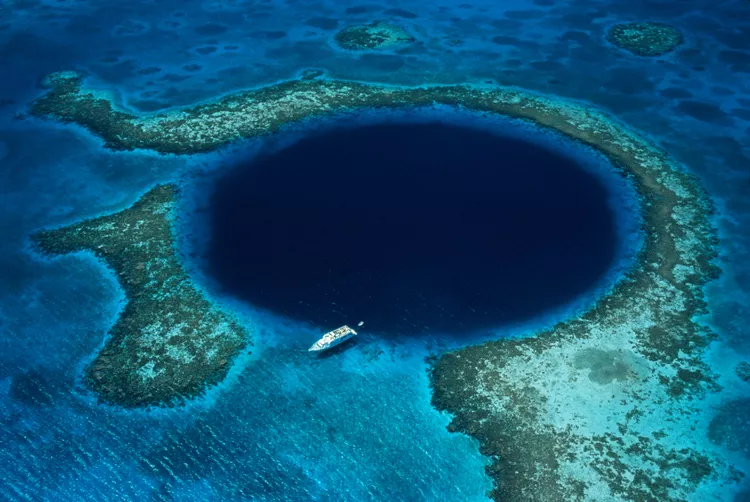Summary
Sandwiched between Mexico, Guatemala, and Honduras on the Caribbean coast of Central America, Belize is a paradise destination renowned for its lush jungles and postcard-perfect beaches. In recent years, it’s also gained a reputation as one of the region’s most rewarding scuba diving destinations.
Balmy water temperatures and excellent visibility are a large part of the attraction; however, what makes Belize special is the proximity of the Mesoamerican Barrier Reef System. This is the second-largest barrier reef system in the world and arguably one of the most pristine, providing food and shelter for a dizzying array of marine species, including at-risk animals like the West Indian manatee and the leatherback turtle.
The Great Blue Hole
Without a doubt, the most famous of Belize’s many dive sites, the Great Blue Hole is the reason that many divers travel to the country in the first place. Located near the center of an offshore atoll called Lighthouse Reef, it is an underwater sinkhole measuring 1,043 feet (318 meters) across and 407 feet (124 meters) deep. Perfectly circular, its vast depth gives the sinkhole a rich blue color that contrasts beautifully with the light turquoise of the surrounding sea.
Now recognized as a UNESCO World Heritage Site, the Great Blue Hole was first explored by Jacques Cousteau in 1971. Cousteau named the hole as one of the world’s top 10 dive sites, and today, full-day trips from the Belize mainland give divers the opportunity to experience its wonder for themselves. Blue Hole dives reach a maximum depth of 132 feet (40 meters) and may only be attempted by advanced divers. Highlights include the hole’s unique stalactite formations and the Caribbean reef sharks that reside in its depths.
Turneffe, Lighthouse Reef and Glover’s Reef Atolls
:max_bytes(150000):strip_icc():format(webp)/GettyImages-688897149-59b8e094aad52b00113595ef.jpg)
The western hemisphere is home to just four coral atolls (ring-shaped coral islands with a lagoon at the center). Of these, three are located in Belize—Lighthouse Reef Atoll, Turneffe Atoll, and Glover’s Reef Atoll. All of them are characterized by abundant coral and colorful fish life, as well as a range of diving conditions suitable for all skill levels.
Lighthouse Reef Atoll is most famous as the location of the Great Blue Hole; thus, divers that opt for a full-day trip to the sinkhole will likely be offered the chance to enjoy shallow dives on the atoll’s reefs as well.
Named after a 17th-century pirate, remote Glover’s Reef Atoll boasts a large, shallow lagoon, and fabulously healthy corals. This location is a great choice for those traveling with non-diving friends or family, as the snorkeling here is exceptional.
Turneffe Atoll is the largest and most accessible of Belize’s atolls. Its protected status has allowed the atoll’s marine life to thrive, making it one of the best options for divers with a limited time frame.
Gladden Spit Marine Reserve
:max_bytes(150000):strip_icc():format(webp)/GettyImages-521980505-582990295f9b58d5b1205470.jpg)
Located in the south of the country near Placencia, Gladden Spit Marine Reserve is one of the best places in Central America to dive with whale sharks—and the only place in the world where one can intentionally interact with them while scuba diving. With a maximum length of over 40 feet (12 meters), the whale shark is the largest fish on Earth. It is also a filter-feeder and poses no threat to humans.
These gentle giants are attracted to Gladden Spit by the spawning of the snapper fish, which coincides with the full moons during spring and summer. While encounters are possible from March to July, the best months for whale shark sightings are April and May. Therefore, it is advisable to plan your trip to coincide with the three or four days immediately before and after the full moon.
Hol Chan Marine Reserve & Shark Ray Alley
:max_bytes(150000):strip_icc():format(webp)/604-9a6007bd13614f659f8ce2cc8fd1004b.jpg)
Situated off the southern tip of Ambergris Caye in the north of Belize, Hol Chan Marine Reserve is the country’s oldest marine protected area. Its focal point is a natural channel in the reef that measures 75 feet (23 meters) across and 30 feet (nine meters) in depth. The reserve is divided into several different habitats, including the coral reef of the channel, a mangrove area, and sensitive seagrass beds.
For divers, the channel is especially rewarding. Strong currents and a wealth of nutrients attract a plethora of marine life, ranging from tropical fish to eagle rays, blacktip sharks, dolphins, and three different species of sea turtles. Additionally, another highlight of the reserve is Shark Ray Alley, a natural gathering site for docile nurse sharks and southern stingrays, where one can interact with both of these species at close quarters.
Caye Caulker
:max_bytes(150000):strip_icc():format(webp)/GettyImages-109086754-59b8ec38054ad900113c8eb5.jpg)
In between Turneffe Atoll and Ambergris Caye lies beautiful Caye Caulker, a narrow coral strip measuring just five miles in length and less than a mile in width. It serves as a laid-back base for excellent diving in the surrounding areas—including the nearby Belize Barrier Reef.
As part of the Mesoamerican Barrier Reef System, the reef supports an incredible variety of marine life, particularly known for its large fish species (think groupers and reef sharks) and its marine mammals, especially dolphins. Caye Caulker’s own Marine Reserve also provides the opportunity to snorkel with stingrays and nurse sharks, making it an exceptional destination for aquatic adventures.




